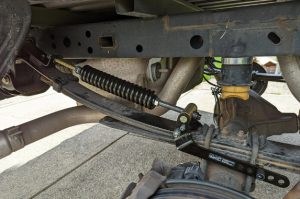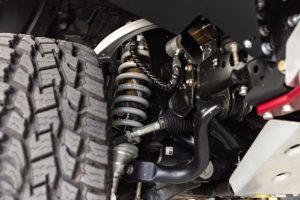Towing places significant additional stress on your vehicle’s suspension system. Whether you’re hauling a trailer, boat, or camper, failing to properly tune your suspension can lead to reduced control, increased tire wear, and potential damage. Understanding how to adjust your suspension for towing is key to safety, performance, and comfort.
In this article, we’ll break down the critical suspension adjustments you need to make before towing and how aftermarket components can help keep your vehicle level, stable, and road-ready.
Why Suspension Tuning Matters When Towing

A standard suspension setup is tuned for typical driving conditions. When towing, the extra load causes:
-
Sagging rear suspension
-
Increased brake distance
-
Poor steering control
-
Higher risk of bottoming out
-
More sway on the highway
Proper tuning helps:
-
Restore ride height
-
Maintain even weight distribution
-
Improve safety and tire longevity
-
Reduce trailer sway
Key Components Affected by Towing
| Component | Towing Effect | Recommended Action |
|---|---|---|
| Springs (Leaf/Coil) | Rear-end sag, reduced ride height | Upgrade to heavy-duty springs or add helper springs |
| Shock Absorbers | Increased compression from load | Use load-rated or adjustable shocks |
| Sway Bars | Increased lateral movement | Upgrade or add rear sway bar |
| Bushings | Accelerated wear | Inspect and replace with polyurethane |
| Air Suspension | May self-adjust or need calibration | Tune air pressure for towing load |
Essential Suspension Adjustments for Towing
1. Upgrade or Add Helper Springs
Helper springs support your existing suspension by increasing load capacity and preventing sag.
Types of helper springs:
-
Leaf helpers (add-on to existing leaf springs)
-
Coil spring boosters
-
Rubber spring inserts
Best for pickup trucks and SUVs with leaf spring setups.
2. Use Load-Rated Shock Absorbers
Standard shocks may compress fully under heavy loads, reducing ride control. Upgrading to heavy-duty or towing-specific shocks improves:
-
Compression handling
-
Stability during acceleration and braking
-
Control during crosswinds or sway
Look for adjustable or monotube gas shocks for better load management.
3. Install or Adjust Air Suspension
Air suspension systems allow real-time ride height adjustment and pressure control. Many modern systems can auto-level based on trailer tongue weight.
| Air Suspension Type | Pros | Cons |
|---|---|---|
| Manual | Affordable, simple | Requires manual adjustment |
| Auto-leveling | Adjusts in real-time | More expensive, complex |
Ideal for vehicles that regularly tow different load weights.
4. Adjust Hitch Height and Load Balance
Improper trailer height can overload the rear axle and lift the front end, causing poor steering and braking.
Tips for hitch alignment:
-
Use a weight-distributing hitch
-
Maintain trailer level to the ground
-
Check tongue weight (should be 10–15% of total trailer weight)
5. Install Rear Sway Bars
Adding or upgrading a rear sway bar reduces body roll and trailer sway, especially when cornering with a load.
Improves lane stability
Reduces sway on crosswinds or uneven pavement
Suspension Maintenance Tips for Towing Vehicles
| Maintenance Task | Frequency |
|---|---|
| Inspect shocks and bushings | Every 10,000–15,000 km or before long hauls |
| Check ride height | Each time trailer weight changes |
| Lubricate suspension joints | Every 6 months |
| Adjust air pressure (if applicable) | Before each tow |
Warning Signs Your Suspension Isn’t Towing-Ready
-
Rear end sits too low under load
-
Steering feels loose or unstable
-
Bouncing or sway when hitting bumps
-
Uneven tire wear or premature shock failure
-
Excessive squat when hitching trailer
If you notice any of these, your vehicle may need an immediate suspension adjustment.
Example Towing Suspension Packages
| Vehicle Type | Recommended Suspension Add-Ons |
|---|---|
| Pickup Truck | Heavy-duty leaf springs, load-rated shocks, rear sway bar |
| SUV | Air suspension, poly bushings, helper coils |
| Van | Adjustable air suspension, upgraded rear shocks |
| 4×4 Towing Camper | Lifted coilovers, adjustable sway bars, bump stops |
When to Consider a Full Suspension Upgrade

If you tow frequently or carry heavy loads over long distances, a full suspension upgrade may be more cost-effective in the long term. Key signs it’s time:
-
Factory suspension bottoms out frequently
-
Repeated shock or spring replacements
-
Unstable ride even after adjustments
In these cases, a professionally tuned towing suspension kit can offer safety, comfort, and durability.
Where to Buy Suspension Parts for Towing
When choosing components for your towing suspension, ensure they’re load-rated and compatible with your vehicle type and towing weight. Buy Suspension online
This store offers a wide range of leaf springs, air suspension kits, shock absorbers, sway bars, and helper spring systems specifically designed for towing setups.
Final Thoughts
Suspension tuning is an essential step before towing — ignoring it can result in unsafe handling and accelerated wear. From simple upgrades like helper springs to advanced systems like air suspension and sway bars, the right setup keeps your vehicle level and in control under any load.
Evaluate your load needs, driving habits, and budget to choose the right suspension components. With a properly tuned system, towing becomes safer, smoother, and more predictable.